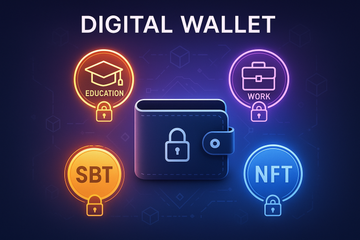You’ve probably heard about NFTs being traded like rare Pokémon cards, flipping wallets, making headlines, all that. But what if some digital assets were, for lack of a better word, stuck with you—like your own name or a badge you earned back in Scouts? Welcome to the quirky world of Soulbound Tokens (SBTs)—crypto’s answer to those certificates and relationships that just shouldn’t be passed around.
What Exactly Are Soulbound Tokens?
Soulbound Tokens are a type of NFT, but with a twist. Unlike standard NFTs, you can’t transfer, sell, or trade these tokens once they land in your wallet. Think of them as digital tattoos: permanent, personal, and totally unique to you (Coinbase).
The term “soulbound” didn’t just appear out of thin air. It’s actually borrowed straight from World of Warcraft, where certain in-game items become inseparable from a player’s character. The concept made its leap into blockchain to solve a practical problem: not every accomplishment or credential should be tradable like coins or collectibles. Can you imagine gifting your university diploma to your cousin just because they asked nicely? Of course not, and that’s the vibe SBTs are aiming to capture.
How SBTs Compare to Good Old NFTs
Okay, let’s talk brass tacks. While both NFTs and SBTs are unique tokens on the blockchain, here’s where they part ways:
- Transferability: NFTs want to party across wallets—SBTs are staying home. Once issued, SBTs stick with your wallet for good.
- Purpose: NFTs can mean digital art, music, or game assets. SBTs, though? They’re much more about identity—think diplomas, certifications, proof you attended an event or have a certain membership.
- Security: SBTs are tied to specific wallets. If someone gets your wallet, those badges are still there, for better or worse (Cointelegraph).
Why Bother? Actual Uses for SBTs
Let’s be honest: at first glance, being “stuck” with a digital badge sounds…boring. But, you know what? It gets a lot more interesting when you look at the possibilities. Here are a few:
- Education Credentials: Imagine your university sends you a shiny new SBT as your degree. No one can scam their way into hiring by faking credentials, and recruiters can instantly check if you’re legit.
- Work Accolades: Job certifications, performance awards, or specialized training can become SBTs, sticking in your wallet as your professional story grows.
- Event Proof: Attending a massive crypto conference or a unique workshop? Organizers could mint SBTs for attendees, making bragging rights immutable (EMURGO).
Frankly, the options stretch further: exclusive memberships, DAO voting rights, even digital criminal records if you’re feeling dystopian. But, let’s not get too ahead of ourselves.
The Techie Bit: How SBTs Actually Work
I know—this part’s not everyone’s cup of coffee, but it’s worth a quick glance. SBTs are built using smart contracts, mostly on Ethereum. Except instead of letting you send your token to someone else, these smart contracts shut that functionality off. They simply store a token in your wallet and call it a day (Cyfrin).
Current standards are still rolling out, though. Some developers are working on ERC-5114 and ERC-5484, proposed technical blueprints to make SBTs more official in the crypto world. But, adoption is still crawling compared to the wildfire growth of NFTs.
Where Do Crypto Wallets Like Trezor and Ledger Fit In?
Here’s the thing: for SBTs to matter, you need a safe digital home. That’s where wallets like Trezor and Ledger step in. These hardware wallets are known for keeping your assets secure from hackers or accidental losses. Now, picture using one of these to store not just your coins, but proof of your digital reputation. If someone swipes your hardware wallet, your SBTs—your professional and personal identities—are still cryptographically tied to you and can be restored if you’ve backed things up correctly.
But it’s not all rainbows. If you lose your private keys and there’s no recovery mechanism, those soulbound trophies are as gone as the socks that disappear in your dryer. The crypto crowd is still figuring out the best ways to link these tokens to more resilient and flexible identity management systems.
What’s Holding SBTs Back?
Let me be real—things aren’t perfect. The whole idea is still new, a bit like assembling IKEA furniture without the manual. Standards for SBTs are still solidifying, and many crypto folks are asking questions: What if someone makes a mistake when minting an SBT? How do you handle fraud or disputed credentials that are eternally stuck to you?
Privacy’s another sticky point. A wallet loaded with SBTs tells a story—maybe too much. That means designers need to think carefully about what gets soulbound and whether some tokens should have a way to expire or hide themselves if needed (CoinBureau).
Are SBTs the Future—Or Just Crypto’s Latest Fad?
Soulbound Tokens open up fascinating new directions for how we handle trust, proof, and reputation online. Instead of trusting screenshots or endless PDFs, SBTs could let us instantly verify skills, achievements, and memberships at a glance. The dream is to make this all as seamless as buying a coffee—no fuss, no drama, just clean proof of who you are and what you’ve done.
But, like lots of things in crypto, we’re not quite there yet. Technical kinks, privacy questions, and adoption hurdles need smoothing out before your digital backpack fills up with SBT badges. Still, with heavy hitters like Ethereum’s Vitalik Buterin eyeing their potential, you can bet this isn’t just a passing trend.
For now, keep an eye on your Ledger or Trezor wallet—one day soon, the keys you protect might be guarding more than just your coin stash. They could be the vault for your digital reputation, career, and proof of every wild or wonderful thing you’ve done online.
And if your crypto-savvy friend brings up SBTs over coffee, you’ll know what to say. They’re not just NFTs you can’t sell—they’re proof that sometimes, in the digital world, some things are meant to stay yours… and yours alone.











